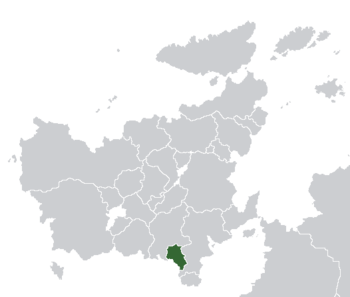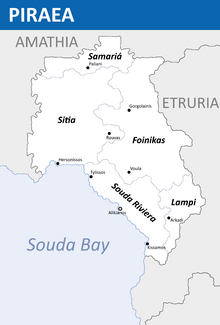Piraea
This article is incomplete because it is pending further input from participants, or it is a work-in-progress by one author. Please comment on this article's talk page to share your input, comments and questions. Note: To contribute to this article, you may need to seek help from the author(s) of this page. |
Piraean Republic Πειραιηκή Δημοκρατία Pireikí Dimokratía (Piraese) | |
|---|---|
| Motto: «Ελευθερία ή Θάνατος» Elefthería í Thánatos "Freedom or Death" | |
| Anthem: "Ύμνος προς την Ελευθερίαν" "The Homeland" | |
 Piraea (dark green) in Euclea (dark grey). | |
| Capital and largest city | |
| Official languages | Piraese |
| Recognised regional languages | Novalian |
| Ethnic groups (2015) | |
| Demonym(s) | Piraean, Piraese |
| Government | Unitary parliamentary republic |
• President | Pavlos Kassapidis |
• Prime Minister | Maria Theopeftatou |
| Legislature | Piraean Senate |
| Establishment | |
• Grand Duchy of Alikianos | 1729 |
• Kingdom of the Piraese | 1857 |
• First Republic | 1947 |
• Second Republic | 1981 |
| Population | |
• 2019 estimate | |
• 2017 census | 7,484,889 |
• Density | 86/km2 (222.7/sq mi) |
| GDP (PPP) | 2019 estimate |
• Total | $207.062 billion |
• Per capita | $27,664 |
| GDP (nominal) | 2019 estimate |
• Total | $113.299 billion |
• Per capita | $15,137 |
| Gini (2018) | low |
| HDI (2017) | very high |
| Currency | Drachma (PRD (₯)) |
| Time zone | Euclean Central Time |
| Date format | dd-mm-yy |
| Driving side | right |
| Calling code | +42 |
| ISO 3166 code | PRA |
| Internet TLD | .pr |
Piraea (Piraese: Πειραιάς), officially the Piraean Republic (Piraese: Πειραιηκή Δημοκρατία) is a country located in Southern Euclea located along the Padarian Sea. It borders Amathia to the north and Etruria to the east. Alikianos is the capital and largest city, followed by Kissamos. Piraea has an area of 86,679 square kilometres (33,467 square miles) and as of 2015 has a population of approximately 7.4 million, most of whom belong to the Amathian Rite Epismialist Church.
The modern Piraean state emerged following the end of the Pereramonic Wars. Under the Treaty of Savona, the Grand Principality of Alikianos was established. The October Uprising saw ethnic Piraeans revolt against Vespasian rule under the Kingdom of Vespasia. Following the diplomatic intervention of the Euclean powers, the Kingdom of the Piraese was established in 1857. During the Great War, Piraea declared support for Gaullica and the Entente. It was defeated and lost Tarpeia to Etruria, resulting in long-lasting tensions over the disputed territory. King Georgios II was forced to abdicate and a regency was established under Prince Paulos. During the regency a low-intensity civil war began between the government and collectivist rebels. The country was unprepared for the Solarian War and the military intervened to oust the Paulos government. The first republic was established after the war but democratic rule ended following a military putsch in 1961 after the military seized power in Etruria. Leftist paramilitary groups began to confront the government again in 1967, resulting in a period of increase violence and government crackdowns. Following protests from student and labor groups over worsening economic conditions, the military government fell and the current system was established in 1981.
Piraea is a unitary parliamentary republic and developed country high standard of living. The current president is Pavlos Kassapidis, who serves as a largely ceremonial head of state. The government is led by the prime minister, currently Maria Maria Theopeftatou. The supreme legislative authority in Piraea is the Piraean Senate. Since democratization began in 1981, the Piraese Socialist Workers Union (PSEE) has consistently been the largest party in the legislature. The country is a member of the Community of Nations, International Council for Democracy, Euclean Defence Treaty Organisation, Global Institute for Fiscal Affairs, and the International Trade Organisation. It has twice been a candidate for membership in the Euclean Community, but both bids have failed. Piraea is not actively pursing membership.
The Piraean economy is dominated by service and industrial sectors. The country also has a strong agriculture sector, with cotton, tobacco, olives, and wine being lead exports. Another significant component of the economy is tourism. Piraea regularly ranks among the most popular tourist destinations in Euclea and in the world. The government controls a portion of the economy, with substantial government expenditure. The Euclean Community is Piraea's most important trading partner. The state provides social security and universal health care systems in addition to tuition-free primary and secondary education. The state supports the advancement of Piraean culture through a number of public institutions, especially found in media and publications. The country has a declining population as a result of rising levels of emigration,fewer births, and a low immigration rate.
Etymology
The name Piraea comes from the Ancient Piraese name Πειραιεύς (Peiraieús), which roughly means 'the place over the passage'. Over time the Ancient Piraese evolved into the (modern Πειραιάς (Piraeus). Piraea is the embricized version of Piraeus.
History
Early history
Classical period
- Various Piraean city-states establish colonies throughout South Euclea and North Couis
- Infighting among the city-states leads to the rise of Lasithi, resulting in the Lasithian Hegemony
- Democracy, philosophy, arts, and the foundations of Eastern civilization
- Rising external and internal threats worsened the Eruption at Juktas, Lasithi's main port, resulted in Lasithian decline
Solarian Rule and High Piraese Period
- Considerable portions of Piraean come under Solarian control
- Territory is re-organized into the Solarian province of Piraia
- The cultural achievements of the High Piraese Period are significant, but are largely attributed to Solaria until more recent historians separated them
Middle Ages
- Rise of the First Piraean Empire
- Invasion of the Tagames, fall of the First Empire, and establishment of the Tagame kingdom
- Tagame expulsion, rule by Amathian entity
- Rise of the Second Piraean Empire
- Wars with Poveglia, fall of the Second Empire and start of the Poveglian Period
Piraean statehood
Grand Principality of Alikianos
Kingdom of the Piraese
Industrialization, the Great War, and the Regency
First Republic and military rule
Following the defeat of the Etrurian Revolutionary Republic in the Solarian War in 1946, το ζήτημα της μοναρχίας (The Question of the Monarchy) dominated post-war Piraean politics. Many reformists and liberals were opposed to restoring the monarchy, which had remained mired in controversy and a prolonged regency following the Great War. However, conservatives and Epismialists supported the continuation of the monarchy under the House of X. Interest in a foreign monarchy, especially one from Werania, had subsided. Despite the plans to put a junior member of the House of Schwarzollen-Brücken on the Piraese throne, Weranian support for Etruria during the Solarian War and its refusal to joint the Community of Nations sponsored intervention made a Weranian monarch unacceptable. A new constitution drafted in 1947 mandated a democratic, representative, and republican government that abolished the monarchy. This angered many conservatives, but the lack of a popular claimant saw minimal public support for the continuation of the monarchy. As such, the First Republic was established. The abolition of the monarchy satisfied the collectivist and republican militias, many of which went became dormant while some evolved into paramilitary groups.
Despite the new democratic constitution, Piraea did not have a strong democratic tradition. This presented problems for the young republic. Suffrage in the kingdom was restricted to landowning males. However, the 1947 constitution expanded suffrage to all men. The majority of the Piraean population was illiterate, meaning many newly enfranchised voters struggled to read the ballots. Electoral fraud became common as a result, as did bribery. The conservative National Democratic Party (EDK) used this to their advantage, often working with the Epismialist clergy to secure victory in elections. They were opposed by the reformist Radical Union (RE), which sought to further liberalize society and build Piraea in the image of other Euclean states. The country attempted to join the Euclean Community in 1955, but is bid was rejected as it did not meet EC standards. Successive governments identified this as a priority and began to implement reforms to meet entry requirements, but where thwarted by corruption and cronyism largely sponsored by the EDK.
The 1960 establishment of the military government in Etruria worried many within the armed forces, who had little faith in the ability of the republic to effectively resist Etruria should another war break out. In 1961, the Etrurian military seized the Apokoronas Islands off the coast of Tarpeia. The civilian government, led by Vassilios Michaloliakos of the RE, was unwilling to go to war and instead lodged a series of diplomatic protests against Etruria. Diplomatic attempts failed to resolve the crisis. Now convinced that the civilian government was unable to stand against the Etrurian military dictatorship, senior officers in the Piraean military staged a bloodless pustch, the second in Piraea's Post-War history. The pustch took place while Michaloliakos was abroad in Kesselbourg lobbying foreign governments to support Piraea in the Apokoronas Incident. He refused to resign as prime minister. In retaliation, the military arrested senior cabinet officials. After this, Michaloliakos resigned and remained in exile in Kesselbourg. The military government began a severe crack down on civil liberties and heavily censored the media, bringing it all under state control. Labor unions were also cracked down on with many forcibly disbanded. Most reformist and leftist parties were outlawed, including the Civic Union, the smaller Piraese Socialist Workers Union, and the People's Collectivist Front. A number of government party officials were arrested and tried by the military government.
The leftist paramilitary groups that did not disband following the war mobilized against the military government, beginning in 1963. The conflict lasted for several years resulting in a number of violent confrontations, kidnappings and terrorist attacks. Global economic downturn in the 1970s presented significant problems for the military government, which collapsed when students began to occupy universities throughout the country. In response, the military government order soldiers to confront the students. However, many of the soldiers were young conscripts and did not wish to fire upon the students, with many conscripts instead declaring loyalty to the students. The Piraese Socialist Workers Union, which had previously gone underground following its prohibition, called for a general strike of all workers. Many workers refused to show up to work or began to occupy their places of work. The military government, fearful of a violent collectivist revolution, collapsed and allowed for civilian rule to continue.
Second Republic
Ioannis Apostolou, who was the once exiled leader of the Piraese Socialist Workers Union (PSEE), returned from exile in Caldia to campaign in the 19XX general election, held under the 1947 constitution. Apostolou's PSEE won a majority of the seats in the election and promised to pursue a new constitution. Despite a push for the restoration of the monarchy from conservative politicians and the Espismalist Church in Piraea, a democratic and republic constitution was promulgated on 1 June 1981.
The socialist PSEE, initially led by Apostolou for over a decade, dominated in government over the next four decades, with occasional interruptions by the conservative Homeland Party (PK). Successive PSEE governments invested significantly in the economy, increasing public spending and social programs. This gave way to significant economic development and helped turn Piraea into a modern Euclean country. Following democratiziation, Piraea saw significant investment from the International Council for Democracy, which further contributed to its economic growth and helped raise its standard of living to previously unprecedented levels. Corruption and cronyism remained a persistent issue, which was combated by different governments. The first PK government was formed under Evangelos Polakis in 1994 and lasted until 1998. During this period, neoliberal economic reform was implemented to fight growing economic stagnation. Polakis was unseated by the PSEE in the 1998 election but led PK to victory in the 2002 election. The 2005 World Financial Crisis significantly impacted Piraea, which saw a housing bubble fostered by Polakis' reforms burst. Polakis was defeated by the PSEE in 2006. The PSEE has governed undisrupted since 2006 and has restored public spending to high levels in order to fight the economic downturn.
Consistent throughout both PSEE and PK governments was the country's second attempt to join the Euclean Community. The process was first initiated in 2002 when Piraea became a candidate to join the EC. Political and economic reform was implemented to bring the country to EC standards, icnluding new anti-corruption legislation. During this period, Piraea saw significant investment from the EC. Following negotiations, it submitted its application alongside Etruria in 2015. Both the Etrurian and Piraean bids were strongly supported by Gaullica, Florena, and Amathia. However, the 2016 Etrurian referendum saw support for enlargement fall and Werania and Estmere effectively blocked Piraea's application. Despite this, Piraea has actively worked to maintain close relations with the EC. Piraea and the nationalist government of Etruria have renewed lingering tensions over Tarpeia and the Apokoronas Islands.
Politics
Governance
The Piraean Republic is a unitary state governed under a parliamentary system. Elections first began in 1873 when Piraea was a monarchy. Suffrage was restricted to land-owning men over 25 years of age and was unchanged until the abolition of the monarch in 1947. Suffrage was then expanded to all male citizens over 21 years of age. However, the majority of the Piraean population was illiterate and as a result electoral fraud and bribery were common. Elections were suspended following the 1961 coup and were not held again until the fall of the military government in 1981. Suffrage was made universal with the return of democratic governance. Under the 1981 constitution, Piraea's fourth, government powers are divided between the executive, legislature, and the judiciary.
The President of the Repblic is the head of state and is appointed by the legislature. Presidents serve six-year terms and are limited by the constitution to a single term. The president has the procedural duty of appointing the prime minister with the consent of the legislature. In addition, the president serves as commander in chief of the armed forces and has some influence over foreign policy. The current president Pavlos Kassapidis who was appointed in 2016. The government is headed by the prime minister, who leads a cabinet of 16 ministers in charge of different government agencies. As the executive branch, the cabinet is responsible for proposing legislation, drafting a budget, implementing and upholding the law, and overseeing foreign and domestic policies. Maria Theopeftatou has served as prime minister since 2014 and comes from the ruling Piraese Socialist Workers Union.
The Piraean Senate is the national parliament located in the Palace of the Republic in Alikianos. The Senate is the supreme legislative body, holding ultimate power over all other political bodies, and represents the citizens through an elected body of Senators. It is unicameral and has 250 members. Elections are held regularly every four years, but may be called earlier. The last election was held in 2018 and the next election must be held no later than 2022. Members are elected by proportional representation. 200 seats are allocated based on votes share, with the remaining 50 are awarded to the largest party.
Political parties and elections
In total, there are seven political parties with representation in the Senate. The two largest are the Piraese Socialist Workers Parry (PSEE) and the Homeland Party (PK). Both parties have formed government since democratization. PSEE is seen as the "party of governance", having only faced two electoral defeats in 1994 and 2002. As a result of PSEE's dominance, Piraea has at times been described as a dominant-party state. The current leader of PK is Nikos Polakis, who leads the official opposition in the Senate.
Other parties in the Senate include the far-right All for the Nation, the Communist Party, the liberal Change!, the Green Alternative, and the Novalian People's Party which represents the ethnic Novalian minority. Additional parties operate at a provincial and municipal level.
Elections to the Senate must be held every four years. When the election is held is up to the discretion of the president, who acts on the advice of the prime minister. Snap elections cannot be called and a full four-year term must be completed before an election can be called. After an election is held, the president invites the leader of the largest party in the Senate to form a government. The last election to the Senate was held in March 2018 and was won by PSEE. The next election can be held no later than December 2022.
Administrative divisions
Since the 1981 constitution, Piraea has consisted of five provinces which are further divided into a total of 429 municipalities. Each province has its own government, which is presided over a provincial governor and a provincial council. These devolved governments have authority over matters such as transportation and are responsible for providing healthcare services and education. The five provinces of Piraea are Fonikas, Lampi, Samariá, Sitia, and the Souda Riviera. Samariá is home to a notable Amathian minority while the largest ethnic group living in Lampi are Novalians. A number of additional divisions exist for statistical purposes, but these have no legal authority or status.
Demographics
With an estimated population of 7.2 million in 2019, Piraea ranks among the smallest nations in Euclea. At the time of the 2017 census, its population density stood at 86 inhabitants per square kilometer. The overall life expectancy in Piraea at birth was 77.8 years in 2018. The fertility rate of 1.44 children per woman is low and has steadily declined since the 1980s, coinciding with the wider Euclean trend of declining fertility and rapid aging. The population is also decreasing as a result of emigration to nations within the Euclean Community. Slowing economic growth has resulted in an estimated 300,000-375,000 Piraeans emigrating since 2010. As a result of these trends, the average Piraean household is smaller and older than previously.
Largest cities or towns in Piraea
Piraean Statistical Office 2017 census | |||||||||
|---|---|---|---|---|---|---|---|---|---|
| Rank | Province | Pop. | |||||||
 Alikianos  Kissamos |
1 | Alikianos | Souda Riviera | 1,380,508 |  Hersonissos  Tylissos | ||||
| 2 | Kissamos | Souda Riviera | 324,676 | ||||||
| 3 | Hersonissos | Sitia | 267,121 | ||||||
| 4 | Tylissos | Souda Riviera | 144,046 | ||||||
| 5 | Voula | Foinikas | 120,833 | ||||||
| 6 | [[]] | [[]] | |||||||
| 7 | [[]] | [[]] | |||||||
| 8 | [[]] | [[]] | |||||||
| 9 | [[]] | [[]] | |||||||
| 10 | [[]] | [[]] | |||||||




